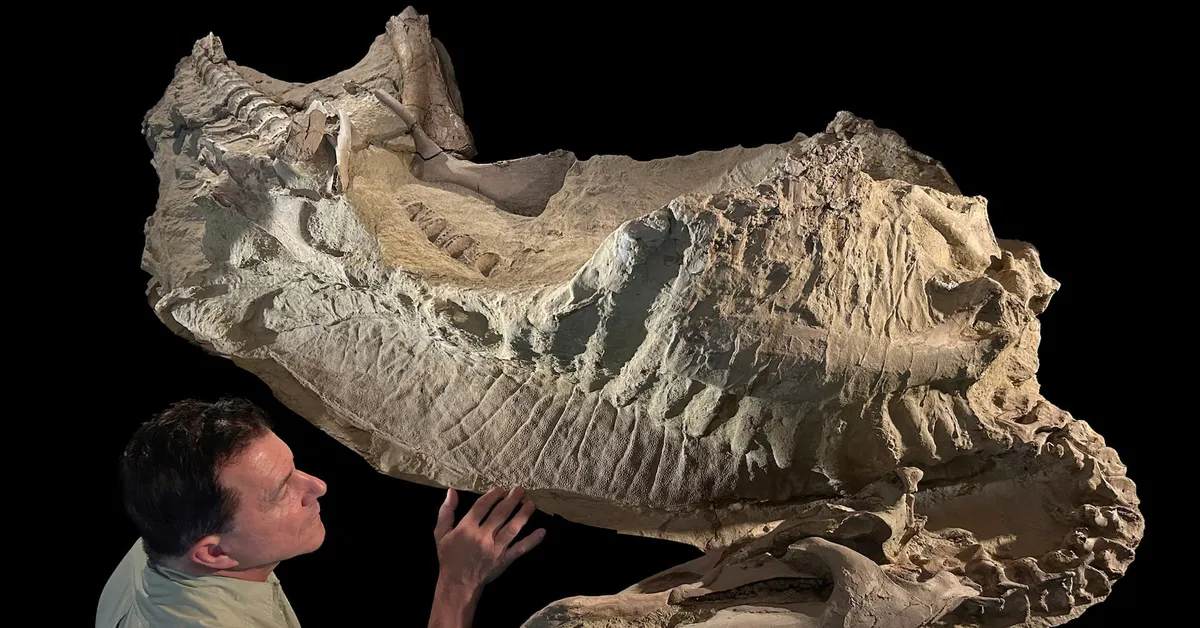
On October 23, 2023, in a groundbreaking revelation, scientists unearthed two fossilized mummies of the duckbilled dinosaur Edmontosaurus in the badlands of Wyoming. This remarkable find has provided researchers with an exquisite view of the dinosaur's external anatomy, showcasing the surprising presence of hooves on its feet—an unprecedented discovery for any dinosaur species.
The two Edmontosaurus specimens date back to the very end of the dinosaur age, approximately 66 million years ago. One specimen is identified as a young adult, measuring around 40 feet (12.2 meters) long, while the other is a juvenile approximately half that size. The preservation of the external fleshy surface is particularly noteworthy, as it was encased in a thin layer of clay, roughly one-hundredth of an inch (0.025 cm) thick, formed shortly after the dinosaurs perished.
While these dinosaurs are referred to as mummies, they differ significantly from the human mummies of ancient Egypt. The term originated from similar fossils found over a century ago in the same region, albeit not excavated with the same meticulous care. Unlike Egyptian mummies, these specimens lack DNA and tissue structure; they are essentially clay masks, as noted by paleontologist Sereno.
The Edmontosaurus thrived during the Cretaceous Period, coexisting with formidable predators such as the Tyrannosaurus rex, the horned dinosaur Triceratops, and the armored dinosaur Ankylosaurus. Sereno emphasizes that the Edmontosaurus was the most prevalent dinosaur in its ecosystem, likening it to the "cow of its day" due to its massive herds. With lengths reaching about 42 feet (12.8 meters), they rivaled the size of the T. rex, which hunted them as evidenced by bite marks found on other fossils.
In a fascinating twist, the Edmontosaurus is recognized as the first dinosaur, reptile, and land vertebrate known to have evolved hooves. These structures serve to protect the toes, support the animal's weight, provide traction, and absorb shock during movement. This evolutionary trait highlights a phenomenon known as convergent evolution, where unrelated species independently develop similar features as they adapt to comparable environments.
According to Sereno, the Edmontosaurus likely walked on all fours at a slow pace but could run on two legs when necessary, drawing a parallel to kangaroos in their movement dynamics. Interestingly, the fossils reveal that the hooves of the forelimbs differed from those of the hindlimbs, showcasing the unique adaptations of this dinosaur.
The fossilized remains also exhibited a continuous midline feature along the body, featuring a fleshy crest along the neck that transitioned into a row of spikes down the tail. The skin was covered in tiny, pebble-like scales, most comparable in size to those of common lizards. Researchers speculate that these two Edmontosaurus individuals may have died during a drought, subsequently being buried in a flash flood that left them encased in clay, a process known as clay templating.
In an effort to further understand these extraordinary finds, the research team, led by Sereno, rediscovered the excavation site in east-central Wyoming where similar dinosaur mummies were unearthed in the early 20th century. During their fieldwork, they also uncovered fossils of Tyrannosaurus rex and Triceratops, which will be detailed in upcoming studies. Notably, findings from the T. rex fossil suggest the possibility that this iconic predator may have had feathers, challenging previous assumptions about its appearance.
This remarkable discovery of fossilized Edmontosaurus mummies not only sheds light on the anatomy and behavior of these ancient creatures but also enhances our understanding of the evolutionary adaptations that allowed them to thrive during the Cretaceous Period.